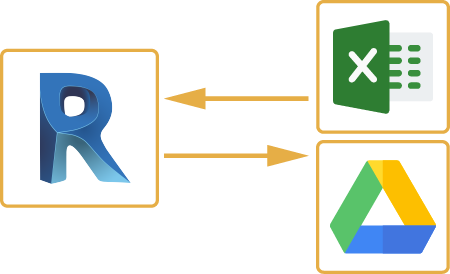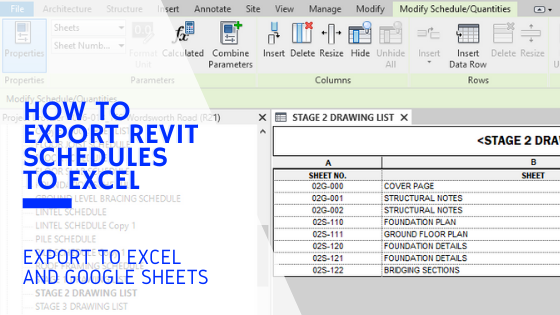Revit Add Ins: Supercharge Your Style and Modeling
Wiki Article
Excel Empowerment: Supercharge Your Revit Projects With Seamless Data Import
With seamless information import, Excel empowerment can be the secret to opening your task's complete capacity. Envision streamlining the import process and optimizing performance via seamless data integration. In this short article, we will certainly share ideas and techniques for utilizing Excel in your Revit jobs.The Power of Excel in Revit Projects
You can supercharge your Revit tasks by taking advantage of the power of Excel for smooth information import. Excel is a functional device that can significantly enhance your operations and efficiency in Revit (revit plugins). With Excel, you can conveniently import and manage big quantities of information, saving you time and initiativeAmong the vital advantages of making use of Master Revit is its capability to take care of complex estimations and formulas. You can use Excel to carry out calculations on your data, such as creating amounts, calculating expenses, or examining efficiency. When functioning with large projects that call for comprehensive estimations., this can be especially useful.

In enhancement, Excel gives a acquainted and straightforward user interface for dealing with data. You can arrange and manipulate your information in a spread sheet layout, making it very easy to see and modify. This can be particularly valuable when working together with others or when you need to make fast changes to your task information.
Moreover, Excel allows you to quickly import and export data between Revit and various other software application applications. You can import data from exterior resources into Revit, such as product requirements or tools routines, and export information from Revit to Excel for more analysis or coverage.
Streamlining Data Import With Master Revit
Streamlining data import in Revit ends up being simpler when utilizing Excel as a device. With Excel, you have the power to flawlessly import and handle big amounts of information in your Revit projects. By making use of the acquainted interface and capability of Excel, you can save time and rise effectiveness in your operations.One of the essential benefits of utilizing Excel for data import in Revit is the capability to conveniently organize and manipulate data before importing it into your job. With Excel's effective features, such as sorting, filtering system, and formulas, you can rapidly cleanse up and style your information to satisfy the demands of your Revit task.
In addition, Excel permits you to import data from different resources, such as databases, spreadsheets, or perhaps online applications. This flexibility provides you the flexibility to gather data from various platforms and combine it right into one main place for simple access and management.
In enhancement, Excel provides the choice to create personalized themes for data import in Revit. By creating design templates customized to your project's certain needs, you can make certain uniformity and precision in your data import process.
Overall, utilizing Excel as a device for information import in Revit enhances the process and enhances your performance. So why not take benefit of this effective tool and supercharge your Revit projects with seamless data import utilizing Excel?
Optimizing Efficiency With Seamless Data Combination
Optimize effectiveness by effortlessly incorporating and taking care of data in your workflow. Gone are the days of by hand inputting data right into your system, losing precious time and sources. With smooth information assimilation, you can improve your procedures and supercharge your efficiency.
When you have a smooth integration system in area,Taking care of data ends up being a wind. You can quickly arrange and classify your data, making it much easier to recover and examine. Say farewell to the days of browsing via endless spreadsheets for that one item of information you require.

Excel Tips and Techniques for Revit Projects
With these ideas and tricks, you'll have the ability to successfully handle your Revit projects making use of Excel. Among the very first points you can do is to utilize Excel's powerful sorting and filtering system features. This will permit you to quickly arrange and assess your project information. As an example, you can arrange elements by their names or filter them based upon specific criteria, such as their standing or place. One more beneficial function is the capability to create formulas in Excel. You can utilize solutions to calculate amounts, do complicated estimations, and even automate certain jobs. This can save you a great deal of time and effort in your Revit jobs. In addition, you can utilize Excel to develop custom design templates for information import and export. By doing this, you can make sure uniformity and precision when transferring data in between Revit and Excel. Finally, do not ignore Excel's conditional format feature. You can use this to highlight certain elements or worths based on specific problems. This can help you swiftly recognize and resolve any kind of problems or abnormalities in your task data. On the whole, understanding these Excel pointers and tricks will substantially improve your capability to take care of and manipulate data in your Revit projects.Taking Advantage Of the Excel-Revit Connection for Success
To make the many of your Excel-Revit connection, benefit from the ability to effortlessly synchronize and transfer task details. By using this effective link, you can supercharge your Revit projects and enhance your operations. With just a couple of straightforward steps, you can import data from Excel straight right into Revit, conserving you time and ensuring precision.Among the vital advantages of the Excel-Revit connection is the capacity to move information flawlessly. Whether you are importing schedules, area revit tool information, and even geometry information, Excel provides an easy to use interface that allows you to organize and manipulate your information before importing it into Revit. This means you can easily upgrade and change your task info in Excel, and with a few clicks, move those adjustments straight into your Revit version.
Along with moving data, the Excel-Revit link also enables synchronization. This suggests that any adjustments made in Excel can be automatically upgraded in Revit, making sure that your project information is always as much as date. This synchronization feature is especially valuable when dealing with intricate and large tasks, as it removes the need for hand-operated information entrance and reduces the risk of mistakes.
Final Thought
By enhancing data import and optimizing performance through smooth data assimilation, you can supercharge your tasks and achieve success. Do not wait any kind of longer, begin harnessing the power of Excel in your Revit tasks today and unlock a globe of opportunities.You can supercharge your Revit jobs by harnessing the power of Excel for seamless information import. With Excel, you have the power to effortlessly import and manage huge amounts of data in your Revit projects (revit plugins). Overall, grasping these Excel methods and suggestions will substantially boost your ability to handle and manipulate data in your Revit tasks
Whether you are importing timetables, area data, or even geometry information, Excel gives an easy to use user interface that enables you to arrange and adjust your data prior to importing it right into Revit. By simplifying information import and taking full advantage of efficiency via seamless data integration, you can supercharge your projects and accomplish success.
Report this wiki page